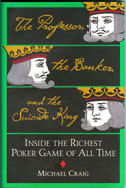
The Professor, the Banker, and the Suicide King
The Story of the Professor, the Banker, and the Suicide King
News travels fast in the poker community, although not necessarily very accurately. This is probably equally true among any other tight-knit group, but when Texas banker Andy Beal started playing a Nick Christenson is widely regarded as one of the best gambling book reviewers publishing today. He is a contributor for Poker Player magazine, and has published in Full-Tilt and Gambling Times. He is also the editor of the very funny 'Casino Death Watch,' which chronicles the comings and goings of casinos in Las Vegas. He is an avid poker and blackjack player. Nick's website is www.jetcafe.org/~npc/ consortium of some of the world's best known poker players in the biggest game ever, it didn't take long for word to get out, or for it to get out of hand. In The Professor, the Banker, and the Suicide King, Michael Craig tries to set the record straight on the details of the largest stakes poker game ever played.
Nick Christenson is widely regarded as one of the best gambling book reviewers publishing today. He is a contributor for Poker Player magazine, and has published in Full-Tilt and Gambling Times. He is also the editor of the very funny 'Casino Death Watch,' which chronicles the comings and goings of casinos in Las Vegas. He is an avid poker and blackjack player. Nick's website is www.jetcafe.org/~npc/ consortium of some of the world's best known poker players in the biggest game ever, it didn't take long for word to get out, or for it to get out of hand. In The Professor, the Banker, and the Suicide King, Michael Craig tries to set the record straight on the details of the largest stakes poker game ever played.
In early 2001 Beal strode onto the world poker scene. He was a newcomer playing in the biggest game in the highest-rolling card room in the world who announced that he wanted to play higher. Several poker professionals rose to the challenge agreeing to match wits with Beal in heads-up limit hold'em poker for ever increasing stakes. This group of pros, which includes such notables as Doyle Brunson, Chip Reese, Howard Lederer, Ted Forrest, Jennifer Harman, and others, may have had the edge in experience, but Beal had a much greater bankroll than all of these legends combined.
Craig has done a heroic job in assembling all of this information in one place. High-stakes gamblers are not always forthcoming about their gambling activities, but Craig deserves praise for getting the principals to talk about both the poker games and the circumstances surrounding them. Necessarily, much of this information was not observed first-hand by the author, and, as one might expect, some recollections about these events differ.
One criticism I would have with the book is that the author often does not differentiate as much as I might like between those situations where there is no disagreement as to the details of what happened and those where the details are less certain. Craig has done this intentionally, sacrificing detailed historical accuracy for the cause of a smoother narrative, and this makes a great deal of sense. The reader should just keep in mind that the goal of The Professor, the Banker, and the Suicide King is intended to be more story than documentary, although I seriously doubt anyone will ever put together a more accurate account of these events.
Another criticism is that there are a few places where Craig gets some of his poker background a little mixed up. For example, some of his discussions about the Deuce-to-Seven World Series of Poker event and Triple Draw get a little muddled, and I have no idea where he might have heard his story about how the hold'em hand of pocket fives got the name "Presto". These are minor complaints, though, that don't significantly detract from the book.
Overall, I was riveted by this story. While there is very little on the play of hands or other strategic information, the recounting of events surrounding the people involved in the big game is detailed, balanced, and fascinating. Very few of us will ever play poker for stakes this high, so for most of us this is as close as we're going to get to this sort of action. The Professor, the Banker, and the Suicide King is a fun read, and I recommend it.
